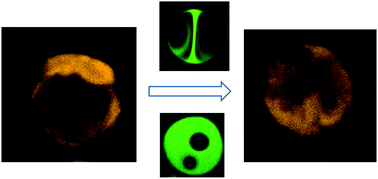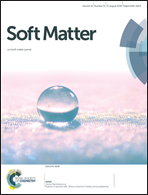Electric field-induced circulation and vacuolization regulate enzyme reactions in coacervate-based protocells†
Abstract
Artificial protocells operating under non-equilibrium conditions offer a new approach to achieve dynamic features with life-like properties. Using coacervate micro-droplets comprising polylysine (PLL) and a short single-stranded oligonucleotide (ss-oligo) as a membrane-free protocell model, we demonstrate that circulation and vacuolization can occur simultaneously inside the droplet in the presence of an electric field. The circulation is driven by electrohydrodynamics and applies specifically to the major components of the protocell (PLL and ss-oligo). Significantly, under low electric fields (E = 10 V cm−1) the circulation regulates the movement of the vacuoles, while high levels of vacuolization produced at higher electric fields can deform or reshape the circulation. By taking advantage of the interplay between vacuolization and circulation, we achieve dynamic localization of an enzyme cascade reaction at specific droplet locations. In addition, the spatial distribution of the enzyme reaction is globalized throughout the droplet by tuning the coupling of the circulation and vacuolization processes. Overall, our work provides a new strategy to create non-equilibrium dynamic behaviors in molecularly crowded membrane-free synthetic protocells.



 Please wait while we load your content...
Please wait while we load your content...